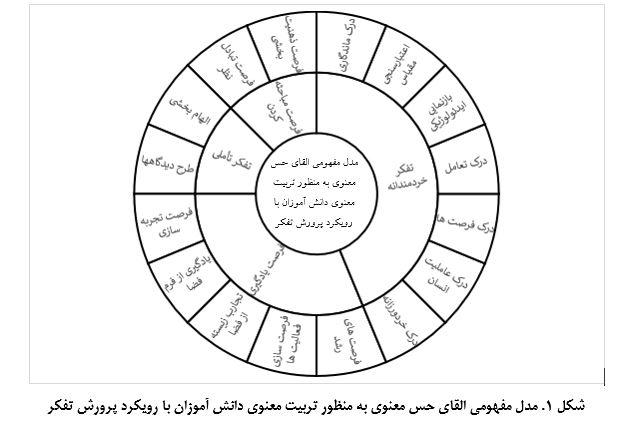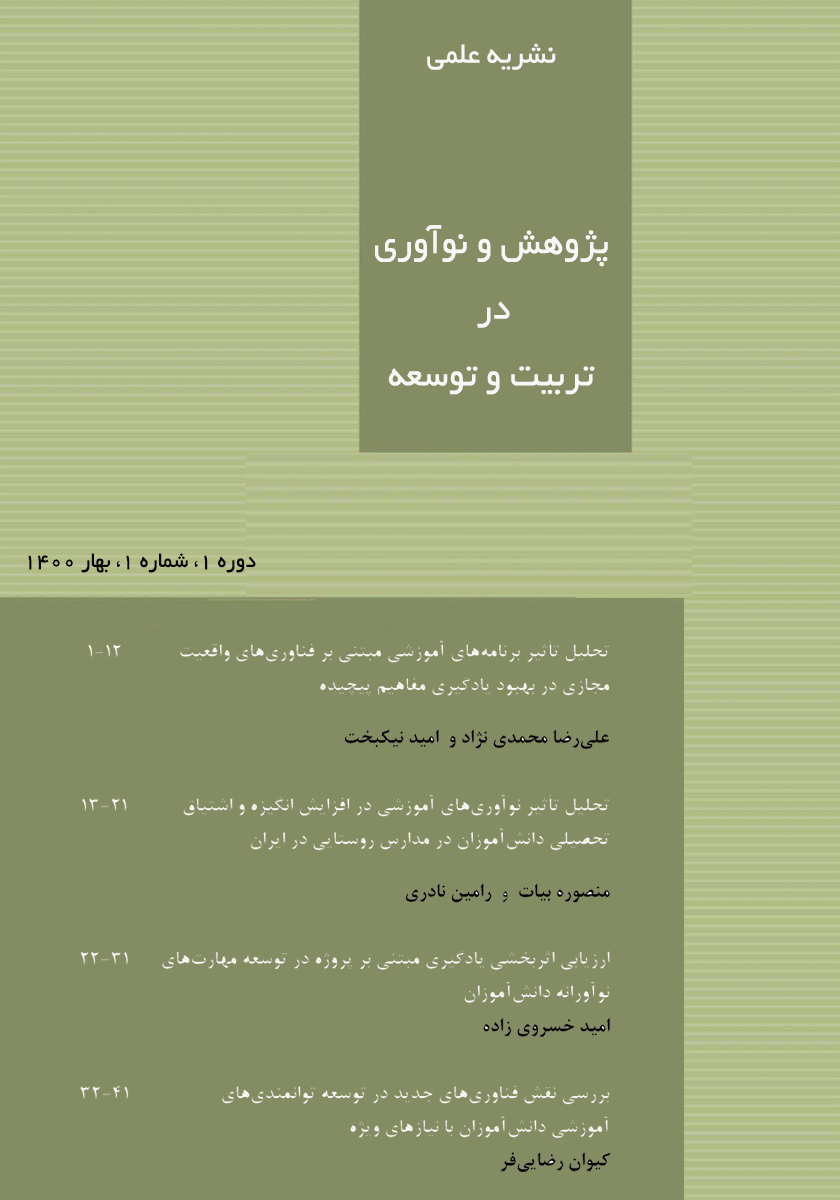Conceptual Model for Inducing a Sense of Spirituality for the Spiritual Education of Students with a Focus on Cultivating Thinking
Keywords:
Spiritual sense, spiritual education, studentsAbstract
This study aimed to present a conceptual model for inducing a sense of spirituality to foster the spiritual education of students, with a focus on cultivating thinking. The research is developmental in purpose and employs a qualitative meta-synthesis approach. The seven-step meta-synthesis method of Sandelowski and Barroso (2007) was used in this study. The research environment included all published domestic and foreign articles (2011-2024). Sampling was purposive and continued until data saturation, proceeding until sample sufficiency was achieved. Data collection tools were printed documents used for review. Data were collected through reputable domestic sites (such as IranDoc, SID, Magiran, NoorMags, etc.) and reputable international sites (Emerald, Sage Publications, Elsevier, Google Scholar, and Springer). Validity and reliability were established through transferability and confirmability. Overall, the results indicated that the conceptual model for inducing a sense of spirituality to foster the spiritual education of students, with a focus on cultivating thinking, includes four dimensions: learning opportunity, reflective thinking, wise thinking, and the opportunity for discussion.
Downloads
References
Eskandari Torbaghan Z, Hossein Gholizadeh R, Kamelnia H. Presenting a Conceptual Framework for Designing the
Physical Space of Elementary Schools Based on Vygotsky's Collaborative Learning Theory. Quarterly Journal of Educational
Innovations. 2019(72):27-52.
Mahdinejad Ja-D, Azmati HR, Sadeqi Habib Abad A. Examining and Re-evaluating the Components Affecting the
Enhancement of 'Spiritual Sense'. Scientific-Research Biannual Journal of Urban Architecture. 2018;6(1):61-78.
Kiani MY. Architecture of Iran in the Islamic Period: Organization for the Study and Compilation of Humanities
Textbooks for Universities; 2012.
Emad F, Movahed K, Taqipour M, Heydari AA. Recognizing Principles for Creating a Sense of Spirituality in the
Surrounding Areas of Religious Spaces in Shiraz, Emphasizing Hierarchical Structure. Urban Research and Planning Quarterly.
;13(49):197-207.
Heydar Netaj V. Improving the Spiritual Quality of Architectural Space through the Recreation of Light Distribution
Patterns in Traditional Iranian Architecture (Designing a Cultural Center in Mashhad): Faculty of Art and Architecture,
Mazandaran University; 2015.
Ghasemi E, Khatami SM, Moti M, Pourjafar MR. Recognition of the Dimensions and Characteristics of SpiritualOriented Urban Spaces. Scientific-Research Journal of Armanshahr. 2023;16(45):73-93.
Gholami HR, editor Reexamining Spiritual Teachings in Iranian Architectural Art (Examining the Influence of
Philosophy and Wisdom in Islamic Iranian Architecture). Second International Congress on Structure, Architecture, and Urban
Development; 2014.
Hedayati F, Rudbarkey Kalari B, editors. Designing Inspirational Classrooms for Students. National Conference on
New Approaches in Education; 2021.
Barhaman M, Salahshouri A. Explaining the Components of Spiritual Education from the Perspective of Imam Ali
(AS). Scientific-Research Quarterly on Nahj al-Balagha Studies. 2020;19(64):79-104.
Kazemi SM, Kalantari Khalil Abadi H. Spiritual Messaging Tools in Mosque Architecture with Emphasis on the Role
of Islamic Ideology. Quarterly Journal of Iranian-Islamic City Studies. 2011;2(6):41-6.
Meqaddadi Z, Mousavi Gilani SR. Spirituality and Wisdom in the Chaharbagh Architectural Style During the Safavid
Period. 2016(5):7-31.
Bojari M, editor Designing Inspiring Educational Spaces in Schools: Advantages and Disadvantages. First National
Conference on Developmental and Educational Psychology; 2022.
Arjmandi H, Tahir MM, Shabankareh H, Shabani MM, Mazaheri F. Psychological and spiritual effects of light and
color from Iranian traditional houses on dwellers. e-BANGI. 2011;6(2):288.
Iqbal N, editor Mosque In The Valley: A Space For Spiritual Gathering & Cultural Learning2015.
Kurnaz A, Erçin A. Development and validation of the inspiration from nature scale for primary school students.
International Journal of Current Educational Studies. 2023;2(1).
Oripova L. A place of enlightenment and spirituality. Multidisciplinary Journal of Science and Technology.
;3(1):42-5.
Rukmana D, Suhandi A, Ramalis TR, Samsudin A. Religious Values-Based Learning Materials on Earth and Space
Science: Analysis Spirituality and Conceptual Understanding Levels. Indonesian Journal of Science and Mathematics
Education. 2022;5(3):271-84.
Kiaček M. Recycling as an inspiration for architecture. Architecture Papers of the Faculty of Architecture and Design
STU. 2021;26(2):14-23.
Malinovskaya E, editor National Schools of the 20th Century: Cultural Identity or Conceptual Choice. 4th
International Conference on Education, Language, Art and Intercultural Communication (ICELAIC 2017); 2017.
Weddle-West K, Hagan WJ, Norwood KM. Impact of college environments on the spiritual development of African
American students. Journal of College Student Development. 2013;54(3):299-314.
Kashim IB, Ogunduyile SR, Adelabu OS. Culturally inspired design education: A Nigerian case study. Industrial
Design: New Frontiers. 2011:81-98.
Hayati H, Behdarvand M. Examining the Evolution of Spatial Organization in School Architecture during the Islamic
Period: A Comparative Study of the Seljuk, Timurid, Safavid, and Qajar Periods. Journal of Islamic Architecture Research.
;10(1):101-26.
Khodabakhshi S, Foroutan M, Samiei A. Exploring the Evolution of School Architectural Spaces Based on the Role
of the Dominant Educational System (Case Study: Sepahsalar School, Dar ul-Fonun, and Alborz High School). Bagh-e Nazar
Quarterly. 2015;12(37):61-74.
Sadoughi Z. Designing Educational Environments with a Human Flourishing Approach Based on Islamic Teachings:
Shahid Rajaee University; 2016.
Loqman M, Mahinfar Fe, Mehrabi S, editors. Review and Identification of Influential Elements in the Perception of
Spiritual Spaces in Mosques. National Conference on Indigenous Architecture and Urbanism in Iran; 2015.
Khamis N, Abdel Moniem Metwalli H. The Formulation of the Cultural Identity of Interior Architecture Students
through the Educational Globalization. Archives of Design Research. 2017.
Lloyd M, Lloyd D, editors. Inspiring school design: an architect's perspective. LINK-University of Hertfordshire;
MahdiNejad JED, Azemati H, Sadeghi Habibabad A. Religion and spirituality: Mental health arbitrage in the body of
mosques architecture. Journal of Religion and Health. 2020;59:1635-51.

Downloads
Published
Submitted
Revised
Accepted
Issue
Section
License
Copyright (c) 2024 Journal of Study and Innovation in Education and Development

This work is licensed under a Creative Commons Attribution-NonCommercial 4.0 International License.










